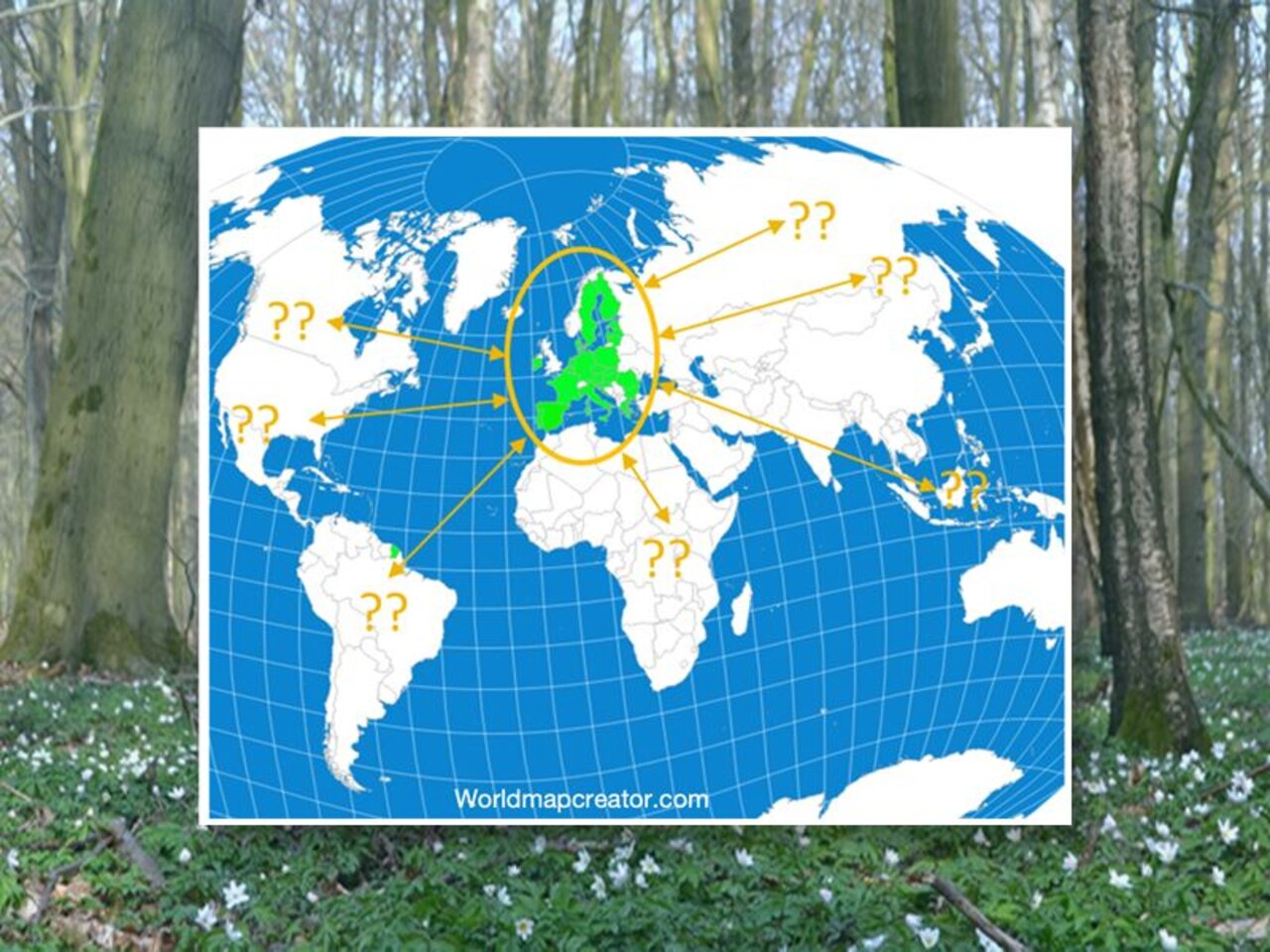Project
Relocation Effects of the EU Biodiversitity Strategy 2030

Assessment of possible relocation effects from the implementation of the EU-COM proposals on the EU Biodiversity Strategy 2030 (EUBDS) on forestry and forests in third countries
The overarching objective of the EU Biodiversity Strategy 2030 (EUBDS) is to protect nature’s biodiversity and to halt and reverse ecosystem degradation in the EU member states. The implementation of additional forest protection and restoration measures will have a negative impact on the roundwood production of the EU member states. Therefore, the aim of this project is to quantify shifts in roundwood production from the EU to third countries and to assess possible biodiversity impacts in the affected countries.
Background and Objective
The overarching objective of the EU Biodiversity Strategy 2030 (EUBDS) is to protect nature’s biodiversity and to halt and reverse ecosystem degradation in the EU member states. It aims to identify pathways to recover biodiversity and ecosystems in the EU through enhanced protection and restoration. Key elements of the strategy include the creation of more strictly protected areas on at least 30% of terrestrial and marine surface and a stricter protection of European primary and old-growth forests.
The implementation of additional forest protection and restoration measures will have a negative impact on the roundwood production of the EU member states. Consequently, it can be assumed that, at least, part of the roundwood production will be relocated to so-called third countries outside the EU. The resulting relocation effects bear the risk of biodiversity loss in the affected third countries. The positive biodiversity effects from the implementation of the EUBDS could thus be counteracted by negative biodiversity effects in third countries that are characterized by a less effective sustainable forest management.
Specific risks include an increasing threat of endangered species, a reduction of intact forest areas together with increasing forest degradation and net deforestation. Against this background, it is important to analyse the global impacts of EUBDS. Therefore, the aim of this project is to quantify shifts in roundwood production from the EU to third countries and to assess possible biodiversity impacts in the affected countries.
Target Group
Policy, Science, Society
Approach
In 2020, researchers of the Thünen Institut of Forestry started to analyze possible leakage effects from the implementation of the EUBDS. The results of this study have been published in German and English in the Thünen Working Paper series (number 159 (en) and 159a (de)). This study has been revised, extended and updated based on new data and by considering two alternative implementation scenarios of the EUBDS.
Compared to the preliminary study, two implementation scenarios show a range on possible changes in protected area coverage, resulting roundwood production levels and related magnitudes of leakage.
Data and Methods
In a first step, two different German roundwood production scenarios due to two alternative implementation scenarios of the EU-BDS are estimated. To estimate alternative levels of roundwood productions, three measures to intensify forest protection are combined. Thereby, scope and extent of the implementation is varied in terms of: (i) proportion of protected forest area, (ii) proportion of strictly protected areas with very high conservation value including "old-growth forests", and (iii) management of protect areas dedicated to roundwood production. Depending on the scenario assumptions, the limitations in regard to forest use and thus, roundwood production varies between the two alternative scenarios and over time. The results obtained for Germany are transferred to the roundwood production of the EU member states.
In a second step, the impact of a reduced EU roundwood production on global forest product markets is assessed. Possible relocation effects are quantified with the help of the Global Forest Products Model (GFPM). The GFPM is a global partial equilibrium model for forest products markets which was adopted and further developed at the TI-WF. Wood production and trade flows are simulated in one reference and the two alternative scenarios which considers the implementation of the EU-BDS in varying intensities. Subsequently, the occurrence and magnitude of relocation effects in third countries are derived from the difference of roundwood production between the reference scenario and the alternative scenarios.
In a third step, the impacts from the relocation of roundwood production to third countries are analyzed and classified. The assessment of the impacts is carried out using a set of indicators to cover the topics of (i) governance, (ii) sustainable forest management, (iii) biodiversity, (iv) forest condition, (v) deforestation pressure as well as (vi) socio-economic aspects.
Results
The model simulation starts in 2017 and calculates up to 2030 and further to 2050 in order to also assess the long-term effects of the measures. The study “Assessment of Possible Production Leakage from Implementing the EU Biodiversity Strategy on Forest Product Markets” reveals that in the reference scenario, EU roundwood production increases from approx. 473 million m³ in 2017 to 539 million m³ by 2030. If the EUBDS measures were implemented, EU roundwood production in 2030 would be 490 million m³ (-9%) in the moderate scenario and 281 million m³ (-48%) in the intensive scenario. While roundwood production is simulated to increase to 586 million m³ by 2050 for the reference scenario, roundwood production is estimated in the EUBDS scenarios to be 521 million m³ in the moderate scenario and 247 million m³ in the intensive scenario. Compared to the baseline situation, roundwood production rises above the 2017 level in the moderate scenario, but falls significantly below that in the intensive scenario.
EU production of wood products increases significantly in the reference scenario. However, limited availability of roundwood in the EUBDS scenarios would lead to less growth in the production of wood products: while positive growth rates are also achieved in the moderate scenario, production growth is stagnant to declining in the intensive scenario. Nevertheless, the calculated apparent consumption of wood products within the EU would not fall noticeably below that of the reference scenario. This is due to a significant decline in exports as well as higher imports.
The comparatively lower EU roundwood production in the two EUBDS scenarios would be offset to about 50-60 % by increasing production in non-EU countries (mainly USA, Russia, Canada, China and Brazil). In part, the forest management standards of these countries differ from the EU. The part of the lower EU production not compensated by other countries (about 40-50%) would lead to a reduction in global roundwood production. Reduced availability of wood and wood products could lead to increased use of products made of e.g. concrete, steel or aluminium, which, at least currently, have a larger carbon footprint than wood products. Thus, the intended benefit for biodiversity protection in the EU could also be at the expense of disadvantages in EU climate protection.
In a further step, it is analysed how the relocation of roundwood production to other countries is to be classified.
The study “Potential leakage of biodiversity risks under the EU Biodiversity Strategy 2030” uses a biodiversity indicator framework to quantify country-wise vulnerability. For this risk assessment, single indicator values are weighted with the results of the above mentioned study on changed timber production under the EUBDS implementation. Most of the indicators point to increasing vulnerability in the affected non-EU countries. Roundwood production would be transferred to countries with, on average, lower governance quality, political awareness, and less sustainable forest management. These countries still have more natural habitat and intact forest landscapes, but higher risks of species extinction and lower shares of protected areas. These results call for additional safeguarding measures to ensure that implementation of EUBDS does not cause harm to ecosystems elsewhere including global conservation and protection schemes. We further conclude, that effective land use planning is needed to balance conservation schemes with roundwood production.
Project brief:
- Expansion of forest protection areas in Europe endangers biodiversity globally. Project brief 2024/07a (EN) | Richard Fischer et al.:
DOI:10.3220/PB1708672725000
Thünen-Contact

Involved Thünen-Partners
- Dieter, Matthias WF Institute of Forestry
- Fischer, Richard WF Institute of Forestry
- Günter, SvenWF Institute of Forestry
- Iost, SusanneWF Institute of Forestry
- Schweinle, Jörg WF Institute of Forestry
- Seintsch, Björn WF Institute of Forestry
- Weimar, Holger WF Institute of Forestry
- Zhunusova, ElizaWF Institute of Forestry
Alumni
Duration
5.2020 - 1.2024
More Information
Project status:
finished
Publikationen
- 0
Fischer R, Schier F, Zhunusova E, Günter S, Iost S, Schweinle J, Weimar H, Dieter M (2024) Ausweitung von Waldschutzgebieten in Europa gefährdet die Biodiversität global. Hamburg: Thünen-Institut für Waldwirtschaft, 1 p, Project Brief Thünen Inst 2024/07, DOI:10.3220/PB1708672364000
- 1
Fischer R, Schier F, Zhunusova E, Günter S, Iost S, Schweinle J, Weimar H, Dieter M (2024) Expansion of forest protection areas in Europe endangers biodiversity globally. Hamburg: Thünen Institute of Forestry, 1 p, Project Brief Thünen Inst 2024/07a, DOI:10.3220/PB1708672725000
- 2
Fischer R, Zhunusova E, Günter S, Iost S, Schier F, Schweinle J, Weimar H, Dieter M (2024) Leakage of biodiversity risks under the European Union Biodiversity Strategy 2030. Conserv Biol 38(3):e14235, DOI:10.1111/cobi.14235
- 3
Schier F, Iost S, Seintsch B, Weimar H, Dieter M (2022) Assessment of possible production leakage from implementing the EU Biodiversity Strategy on forest product markets. Forests 13(8):1225, DOI:10.3390/f13081225
- 4
Schier F, Iost S, Seintsch B, Weimar H, Dieter M (2022) Wo kommt künftig das Holz her? Bauernzeit 63(35):8-9
- 5
Dieter M, Weimar H, Iost S, Englert H, Fischer R, Günter S, Morland C, Roering H-W, Schier F, Seintsch B, Schweinle J, Zhunusova E (2020) Abschätzung möglicher Verlagerungseffekte durch Umsetzung der EU-KOM-Vorschläge zur EU-Biodiversitätsstrategie auf Forstwirtschaft und Wälder in Drittstaaten. Braunschweig: Johann Heinrich von Thünen-Institut, 85 p, Thünen Working Paper 159a, DOI:10.3220/WP1604417204000
- 6
Dieter M, Weimar H, Iost S, Englert H, Fischer R, Günter S, Morland C, Roering H-W, Schier F, Seintsch B, Schweinle J, Zhunusova E (2020) Assessment of possible leakage effects of implementing EU COM proposals for the EU Biodiversity Strategy on forests and forest management in non-EU countries. Braunschweig: Johann Heinrich von Thünen-Institut, 80 p, Thünen Working Paper 159, DOI:10.3220/WP1604416717000








